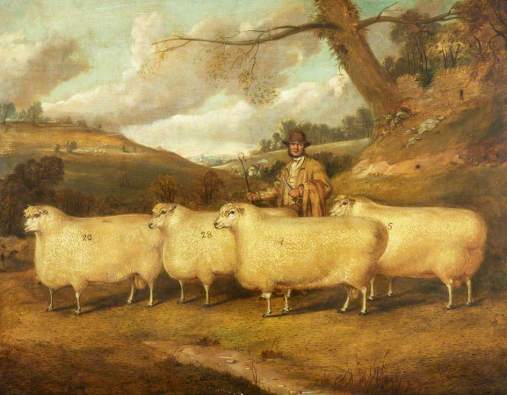
Richard Whitford was born in Evesham, Worcester in about 1821. After initially training as an excise officer and being posted to Manchester, he was sacked for embezzlement and returned to Evesham.
Around this time he decided to try his luck as a painter specialising in painting animals, especially farm stock, many of which included the animal’s owners. Queen Victoria owned some paintings by Whitford, which were hung at Shaw Farm, Windsor, although they no longer form part of the Royal Collection. Whitford was quick to see the commercial possibilities of royal patronage and began to sign his work “animal painter to the Queen.” In 1866 he completed this picture of Mr Garne, a member of a large farming family living around the picturesque Cotswold village of Northleach at that time. He is pictured standing behind his four prize rams, clearly part of a much larger herd judging by the numbers branded just above their shoulders.
The Cotswold sheep is enshrined in the mystique of the Cotswolds. The word Cotswold, of course, is actually derived from the wolds (hills) and cotes (enclosures) which housed the sheep in bad weather. Much like the farmers whose unique skills have allowed them to eke out a living on the Cotswolds, the sheep possess characteristics ideally suited to life in the wolds. From birth the lambs are particularly hardy and can thrive even when food is sparse. Indeed they are known for their longevity and ability to breed successfully to a ripe old age. They are a breed well-suited to both the production of wool and of meat. Their flesh has a very mild flavour which continues to be a popular choice amongst chefs. Much like Cotswold stone their wool is strong and blessed with a golden sheen. If properly hand-combed Cotswold wool is also very luxurious, having once been commonly known as poor man’s mohair.
Unfortunately, the evolution of farming to cope with the demands of the modern marketplace has meant a steady decline in the sheep’s popularity as a commercial breed, to the extent that it is now classed as a minority breed. Despite this the breed can still be seen on many Cotswold farms and tasted on many fine restaurant menus.